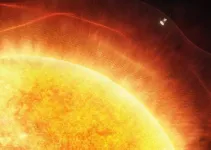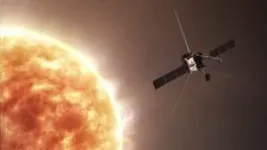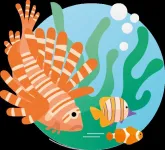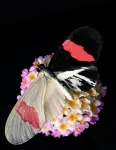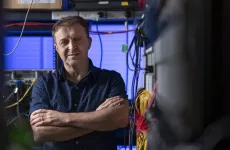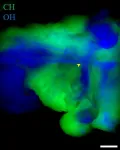(Press-News.org) Since the 1960s, astronomers have wondered how the Sun’s supersonic “solar wind,” a stream of energetic particles that flows out into the solar system, continues to receive energy once it leaves the Sun. Now, thanks to a lucky lineup of a NASA and an ESA (European Space Agency)/NASA spacecraft both currently studying the Sun, they may have discovered the answer — knowledge that is a crucial piece of the puzzle to help scientists better forecast solar activity between the Sun and Earth.
A paper published in the Aug. 30, 2024, issue of the journal Science provides persuasive evidence that the fastest solar winds are powered by magnetic “switchbacks,” or large kinks in the magnetic field, near the Sun.
“Our study addresses a huge open question about how the solar wind is energized and helps us understand how the Sun affects its environment and, ultimately, the Earth,” said Yeimy Rivera, co-leader of the study and a postdoctoral fellow at the Smithsonian Astrophysical Observatory, part of Center for Astrophysics | Harvard & Smithsonian. “If this process happens in our local star, it’s highly likely that this powers winds from other stars across the Milky Way galaxy and beyond and could have implications for the habitability of exoplanets.”
Previously, NASA’s Parker Solar Probe found that these switchbacks were common throughout the solar wind. Parker, which became the first craft to enter the Sun's magnetic atmosphere in 2021, allowed scientists to determine that switchbacks become more distinct and more powerful close to the Sun. Up to now, however, scientists lacked experimental evidence that this interesting phenomenon actually deposits enough energy to be important in the solar wind.
“About three years ago, I was giving a talk about how fascinating these waves are,” said co-author Mike Stevens, astrophysicist at the Center for Astrophysics. “At the end, an astronomy professor stood up and said, ‘that's neat, but do they actually matter?’”
To answer this, the team of scientists had to use two different spacecraft. Parker is built to fly through the Sun’s atmosphere, or “corona.” ESA's and NASA’s Solar Orbiter mission is also on an orbit that takes it relatively close to the Sun, and it measures solar wind at larger distances.
The discovery was made possible because of a coincidental alignment in February 2022 that allowed both Parker Solar Probe and Solar Orbiter to measure the same solar wind stream within two days of each other. Solar Orbiter was almost halfway to the Sun while Parker was skirting the edge of the Sun's magnetic atmosphere.
“We didn't initially realize that Parker and Solar Orbiter were measuring the same thing at all. Parker saw this slower plasma near the Sun that was full of switchback waves, and then Solar Orbiter recorded a fast stream which had received heat and with very little wave activity,” said Samuel Badman, astrophysicist at the Center for Astrophysics and the other co-lead of the study. “When we connected the two, that was a real eureka moment.”
Scientists have long known that energy is moved throughout the Sun‘s corona and the solar wind, at least in part, through what are known as "Alfvén waves.” These waves transport energy through a plasma, the superheated state of matter that makes up the solar wind.
However, how much the Alfvén waves evolve and interact with the solar wind between the Sun and Earth couldn't be measured — until these two missions were sent closer to the Sun than ever before, at the same time. Now, scientists can directly determine how much energy is stored in the magnetic and velocity fluctuations of these waves near the corona, and how much less energy is carried by the waves farther from the Sun.
The new research shows that the Alfvén waves in the form of switchbacks provide enough energy to account for the heating and acceleration documented in the faster stream of the solar wind as it flows away from the Sun.
“It took over half a century to confirm that Alfvenic wave acceleration and heating are important processes, and they happen in approximately the way we think they do,” said John Belcher, emeritus professor from the Massachusetts Institute of Technology who co-discovered Alfvén waves in the solar wind but was not involved in this study.
In addition to helping scientists better forecast solar activity and space weather, such information helps us understand mysteries of the universe elsewhere and how Sun-like stars and stellar winds operate everywhere.
“This discovery is one of the key puzzle pieces to answer the 50-year-old question of how the solar wind is accelerated and heated in the innermost portions of the heliosphere, bringing us closer to closure to one of the main science objectives of the Parker Solar Probe mission,” said Adam Szabo, Parker Solar Probe mission science lead at NASA.
By Megan Watzke
Center for Astrophysics | Harvard & Smithsonian
END
NASA, ESA missions help scientists uncover how solar wind gets energy
Since the 1960s, astronomers have wondered how the Sun’s supersonic “solar wind,” a stream of energetic particles that flows out into the solar system, continues to receive energy once it leaves the Sun. Now, they may have discovered the answer
2024-08-30
ELSE PRESS RELEASES FROM THIS DATE:
Biodiversity loss: Many students of environment-related subjects are partly unaware of the causes
2024-08-30
Worldwide survey by Goethe University FrankfurtFRANKFURT. Of the estimated 10 million, mostly still undiscovered species of flora and fauna on Earth, one million could become extinct in the next decades. This loss of biodiversity would have dramatic consequences, as animals and plants are providers of multiple services: They maintain ecosystems, ensure a more balanced climate on our planet, and supply us with food and active substances for medical drugs. Put bluntly: Without biodiversity, we humans will not survive.
That is why there is an urgent need for resolute political measures to counter the “sixth mass extinction” in Earth’s history. One group of people who are particularly ...
UTHealth Houston and Baylor College of Medicine collaborate on first CDC Injury Control Research Center in Southwest, established to study injury and violence prevention
2024-08-30
The only Injury Control Research Center in Texas has been established by the Centers for Disease Control and Prevention at UTHealth Houston in partnership with Baylor College of Medicine.
“I’m beyond thrilled to bring an Injury Control Research Center to Texas,” said Jeff Temple, PhD, director of the new center and associate dean for clinical research at UTHealth Houston School of Behavioral Health Sciences. “This collaboration between the community, policymakers, UTHealth Houston, and Baylor College of Medicine will undoubtedly save lives.”
An Injury Control Research ...
New findings on TB could change how we treat inflammatory disorders
2024-08-30
Tuberculosis is a confounding scourge. It’s the leading cause of death from infectious disease in the world, and yet it’s estimated that those deaths represent perhaps 5% of infections with Mycobacterium tuberculosis (Mtb). Antibiotics can take credit for saving the lives of some of those with Mtb, but a chasm nevertheless persists between the prevalence of infection and the targeted severity of its impact. A growing body of evidence suggests genetic vulnerabilities to TB account for that gap.
Now researchers from ...
Research Spotlight: A blood-based assay for the detection of IDH1.R132H-mutant gliomas
2024-08-30
Leonora Balaj, PhD, an investigator in the department of Neurosurgery at Massachusetts General Hospital and an assistant professor of Neurosurgery at Harvard Medical School, is co-senior author of a new paper in Nature Communications, Clinical Utility of a Blood Based Assay for the Detection of IDH1.R132H-Mutant Gliomas.
Bob Carter, MD, chair of Neurosurgery at Mass General, is co-senior author of the study. Syeda Maheen Batool, MD, an instructor in investigation in Neurosurgery at Mass General, is lead author.
Background:
Glioma represents the most common central nervous system cancer in adults. The current ...
Genomic dark matter solves butterfly evolutionary riddle
2024-08-30
[Note: High-resolution images related to this research available for download at this link. Caption and credit information provided.]
WASHINGTON (August 30, 2024) — A team of international researchers has uncovered a surprising genetic mechanism that influences the vibrant and complex patterns on butterfly wings. In a study published in the Proceedings of the National Academy of Sciences, the team, led by Luca Livraghi at the George Washington University and the University of Cambridge, discovered ...
Like people, vultures get set in their ways and have fewer friends as they age
2024-08-30
Key takeaways
Young griffon vultures move frequently between sleeping sites in different locations, interacting with many friends.
They get set in their ways as they age and roost in the same spots with the same individuals; older vultures follow the same paths.
Roosts act as information hubs; older vultures may have a more thorough knowledge of where to find food resources and less need to learn about them from other vultures.
If you’d rather be watching TV on your couch than dancing at the club, you might have something in common with aging ...
Not just a ‘bad guy,’ Tau also plays a ‘good guy’ role protecting our brains
2024-08-30
A study by researchers at Baylor College of Medicine and the Jan and Dan Duncan Neurological Research Institute (Duncan NRI) at Texas Children’s Hospital, reveals that the protein Tau – a key player implicated in several neurodegenerative conditions including Alzheimer’s disease – also plays a positive role in the brain. Tau mitigates neuronal damage caused by excessive reactive oxygen species (ROS) or free radicals and promotes healthy aging. The study was published in Nature Neuroscience.
“ROS ...
Doughnut-shaped region found inside Earth’s core deepens understanding of planet’s magnetic field
2024-08-30
A doughnut-shaped region thousands of kilometres beneath our feet within Earth’s liquid core has been discovered by scientists from The Australian National University (ANU), providing new clues about the dynamics of our planet’s magnetic field.
The structure within Earth’s liquid core is found only at low latitudes and sits parallel to the equator. According to ANU seismologists, it has remained undetected until now.
The Earth has two core layers: the inner core, a solid layer, and the outer core, a liquid layer. Surrounding the Earth’s core is the mantle. The ...
Study combines data, molecular simulations to accelerate drug discovery
2024-08-30
Researchers from the University of Cincinnati College of Medicine and Cincinnati Children’s Hospital have found a new method to increase both speed and success rates in drug discovery.
The study, published Aug. 30 in the journal Science Advances, offers renewed promise when it comes to discovering new drugs.
“The hope is we can speed up the timeline of drug discovery from years to months,” said Alex Thorman, PhD, co-first author and a postdoctoral fellow in the Department of Environmental and Public ...
NCT/UCC Dresden: Millions in funding from the Chan Zuckerberg Initiative for state-of-the-art imaging to accurately detect minute tumors
2024-08-30
The imaging techniques currently used in biological research cannot penetrate into deeper tissue layers. In cancer treatment, this means that remnants of tumors or individual cancer cells at tumor margins and in lymph nodes are not visible. Doctors performing surgery are therefore repeatedly faced with the difficult question of whether all of the affected tissue has actually been removed. For the patient's quality of life, however, the complete removal of the tumor is just as essential as the preservation of healthy tissue ...
LAST 30 PRESS RELEASES:
Manta rays create mobile ecosystems, study finds
Study: Mixed results in using lipoic acid to treat progressive multiple sclerosis
Norbert Holtkamp appointed director of Fermi National Accelerator Laboratory
New agentic AI platform accelerates advanced optics design
Biologists discover neurons use physical signals — not electricity — to stabilize communication
Researchers discover that a hormone can access the brain by hitchhiking
University of Oklahoma researcher awarded funding to pursue AI-powered material design
Exploring how the visual system recovers following injury
Support for parents with infants at pediatric check-ups leads to better reading and math skills in elementary school
Kids’ behavioral health is a growing share of family health costs
Day & night: Cancer disrupts the brain’s natural rhythm
COVID-19 vaccination significantly reduces risk to pregnant women and baby
The role of vaccination in maternal and perinatal outcomes associated with COVID-19 in pregnancy
Mayo Clinic smartwatch system helps parents shorten and defuse children's severe tantrums early
Behavioral health spending spikes to 40% of all children’s health expenditures, nearly doubling in a decade
Digital cognitive behavioral treatment for generalized anxiety disorder
Expenditures for pediatric behavioral health care over time and estimated family financial burden
Air conditioning in nursing homes and mortality during extreme heat
The Alps to lose a record number of glaciers in the next decade
What makes a good proton conductor?
New science reporting guide published for journalists in Bulgaria
New international study reveals major survival gaps among children with cancer
New science reporting guide published for journalists in Turkey
Scientists develop a smarter mRNA therapy that knows which cells to target
Neuroanatomy-informed brain–machine hybrid intelligence for robust acoustic target detection
Eight SwRI hydrogen projects funded by ENERGYWERX
The Lundquist Institute and its start-up company Vitalex Biosciences Announces Strategic Advancement of Second-Generation fungal Vaccine VXV-01 through Phase 1 Trials under $40 Million Competitive Con
Fine particles in pollution are associated with early signs of autoimmune disease
Review article | Towards a Global Ground-Based Earth Observatory (GGBEO): Leveraging existing systems and networks
Penn and UMich create world’s smallest programmable, autonomous robots
[Press-News.org] NASA, ESA missions help scientists uncover how solar wind gets energySince the 1960s, astronomers have wondered how the Sun’s supersonic “solar wind,” a stream of energetic particles that flows out into the solar system, continues to receive energy once it leaves the Sun. Now, they may have discovered the answer
